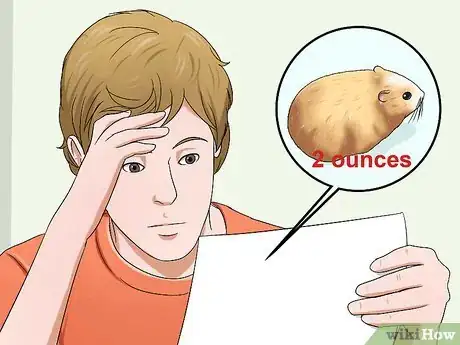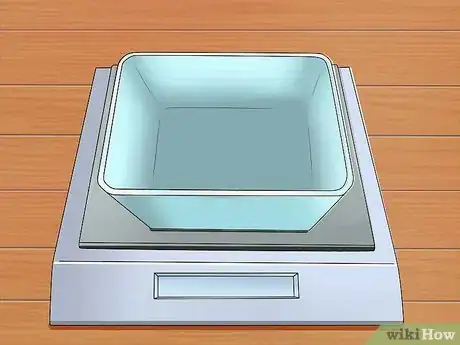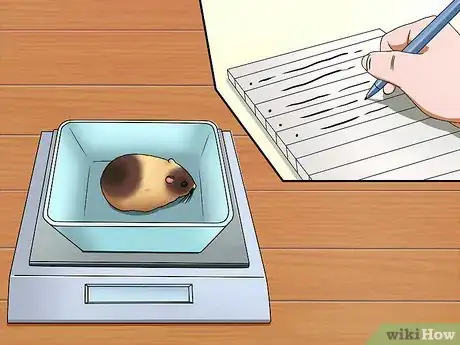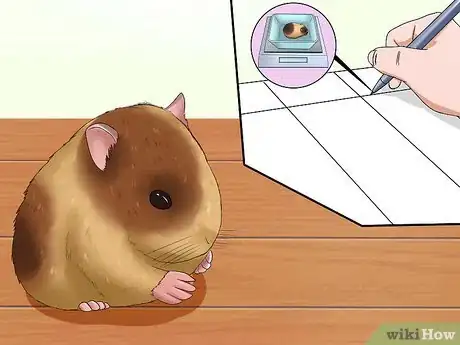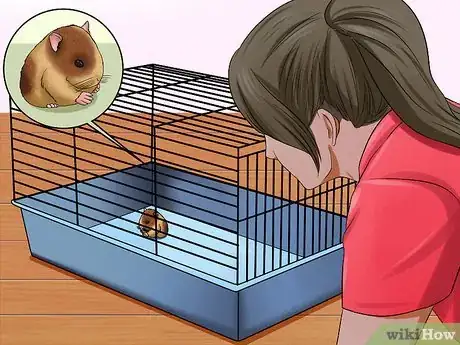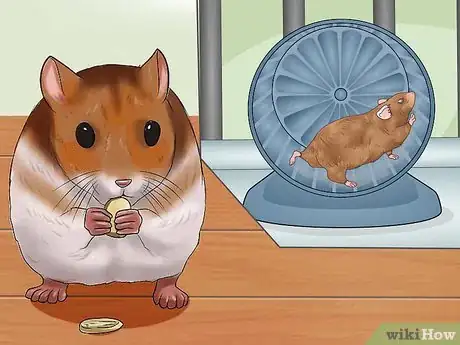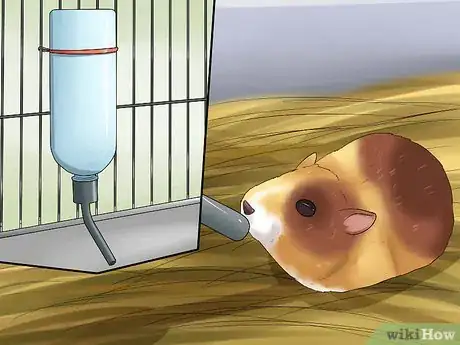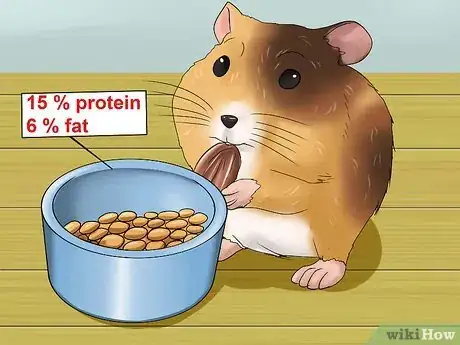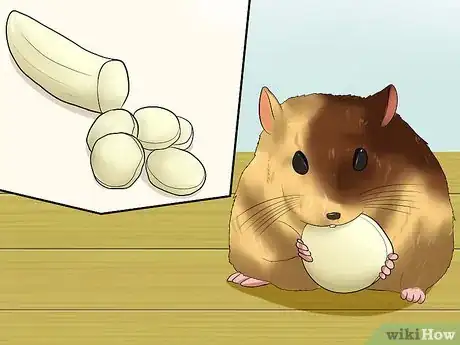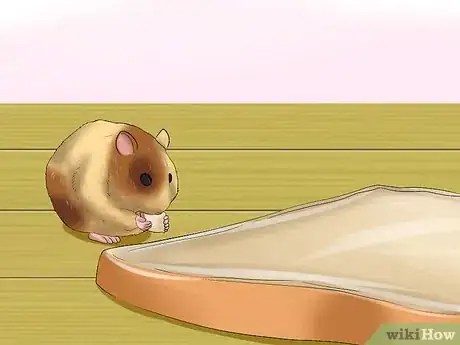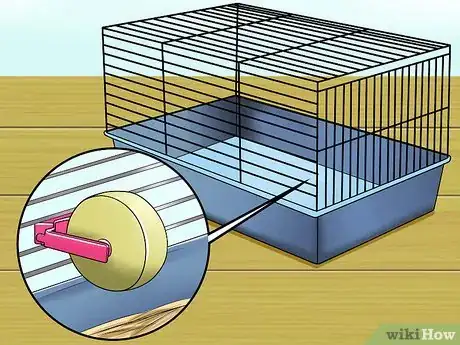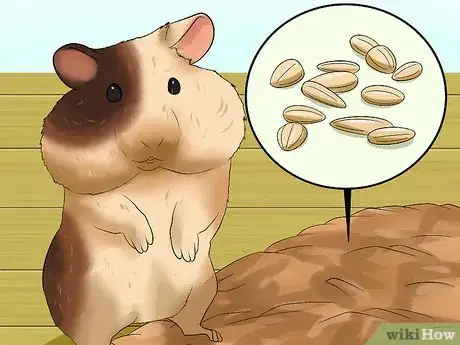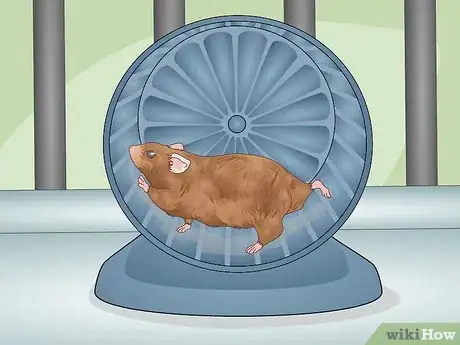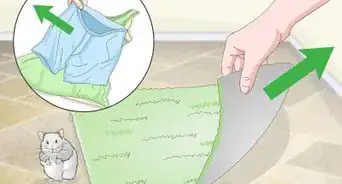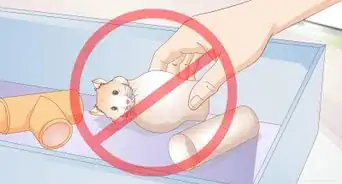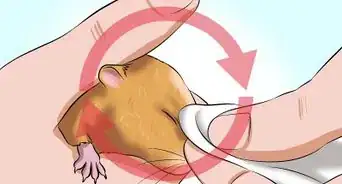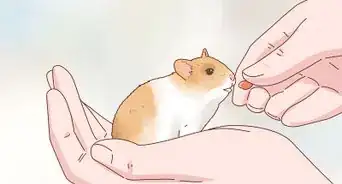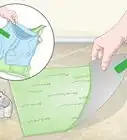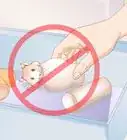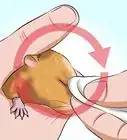This article was co-authored by Pippa Elliott, MRCVS. Dr. Elliott, BVMS, MRCVS is a veterinarian with over 30 years of experience in veterinary surgery and companion animal practice. She graduated from the University of Glasgow in 1987 with a degree in veterinary medicine and surgery. She has worked at the same animal clinic in her hometown for over 20 years.
There are 12 references cited in this article, which can be found at the bottom of the page.
This article has been viewed 65,712 times.
Dwarf hamsters are tiny species of hamster that only grow to be 2–4 inches (5.1–10.2 cm) long.[1] Even though all hamsters have really fast metabolisms, they can still get chubby if they're fed too much or don't exercise enough. A dwarf hamster's lifespan can be between 1.5 and 3 years. You should keep track of your hamster's weight on a regular basis throughout his life so you can alter his diet and/or exercise to keep him healthy. However, a hamster's weight alone isn't a sign of obesity. A hamster that weighs above average, but is healthy, active, and eating properly, should not cause you concern.
Steps
Checking Your Hamster's Weight
-
1Know a dwarf hamster's average adult weight. In general, there are three different species of dwarf hamsters that are kept as pets — Russian or Siberian dwarf hamsters, Roborovski dwarf hamsters, and Chinese dwarf hamsters. Each species of hamster has a slightly different average weight range, as follows:[2]
- A Russian or Siberian dwarf hamster, also known as a Winter White or Campbell's dwarf hamster, normally weighs 1.5–2 ounces (43–57 g) on average.
- A Roborovski dwarf hamster will normally weigh 1–1.5 ounces (28–43 g) on average.
- A Chinese dwarf hamster will normally weigh 1.5–1.8 ounces (43–51 g) on average.
-
2Find a scale suitable to weigh your hamster. In order for the weight of your hamster to register on a scale, the scale needs to be one designed for items like food or postal items. Based on the average weight of a dwarf hamster, the scale needs to be able to read weights as low as 1 ounce (28 g). Scales such as these can be found at kitchen stores or department stores, or even online.[3]Advertisement
-
3Weigh your hamster. Hamsters aren't known for sitting still for very long periods of time! As such, you'll need to entice your hamster to stay on the scale long enough to obtain a weight. If you find your hamster won't stay on her own, you can try the following tricks to weigh her:[4]
- Place a very small box or container on top of the scale. This box needs to be big enough to hold your hamster, but small enough to fit on the scale.
- Place a couple of treats or seeds inside the box or container.
- Reset the scale to zero so the weight of the box and treats aren't included in the measurement.
- Place your hamster inside the box or container and hold your hand over top to discourage her from escaping.
- Take note of the weight.
-
4Keep track of your hamster's weight. Once you know what your hamster weights, write it down in a chart. From this point forward weigh your hamster on a regular basis — once a month, or once every few months. Each time you weigh your hamster, write it down in the chart. And, each time you weigh your hamster, compare his actual weight to the average adult weights for that hamster breed.[5]
- Baby hamsters will obviously weigh quite a bit less than adult hamsters, so you won't need to compare your hamster's weight to the adult average until he's at least 12 weeks old.
- If your hamster weights significantly more than the average adult weight for that hamster species, your hamster could be obese.
-
5Observe your hamster's general health regularly. Comparing your hamster's weight to the average adult weight of that species of hamster is one way to determine if your hamster is overweight, but it's not the only way. If you hamster has a higher than average weight, but she's active, energetic, bright-eyed, and eating properly, she may not be obese, just higher than average.[6]
- If you hamster is showing signs of illness, in addition to being over the average weight for her species, there's a significant chance your hamster is obese.
- Look for general signs of illness like dull eyes and fur, laziness and excessive sleep, and a serious lack of energy and activity.
- Feel for the amount of fat that covers your hamster's bones. OK, hamsters are tiny, but you should be able to get an appreciation of where her ribs are and her backbone. If you can't and there is padding between your fingertips and the spine, then the hamster is likely to be obese.
-
6Put your hamster on a diet. If you find that your hamster has an above-average weight, and he's gotten a little lazy, it may be time to put him on a healthier diet with more time for exercise. Allowing your hamster to stay overweight for too long is very unhealthy and can lead to more serious problems, such as: a reduced lifespan, type 2 diabetes, heat intolerance, skin issues, heat, and other circulatory system problems.[7]
- A hamster diet simply means you need to follow a regular schedule and only provide your hamster with the proper amounts of food every day. You should also give your hamster the opportunity to do a variety of activities every day.
- The combination of both a healthy diet and regular exercise should get your hamster back to an average weight. If, however, your hamster has been overweight for a long time, or he is showing other signs of illness, you should take him to your veterinarian to be examined.
- If you have concerns about your hamster's diet, take him to your veterinarian and get help on what and how much to feed your hamster in order to help him lose weight.[8]
Keeping Your Hamster Healthy and Fit
-
1Ensure your hamster always has access to water. Hamsters, just like most pets, need access to a source of fresh water 24 hours a day. Because hamsters spend the majority of their time inside their cages, the best source of water is via a water bottle that hangs on the side of the cage.[9] While the water bottle may hold enough water to last more than one day, it is best to refill your hamster's water bottle every day.[10]
- While a hamster can drink out of a water bowl, they aren't recommended. Not only can bowls tip easily (which means you have to clean the cage more often) but it's easy for your hamster to get her poop or bedding in the water.
- An average, inexpensive water bottle will most likely be made of plastic. But because hamsters like to chew things, plastic water bottles (and plastic food dishes, and plastic anything) will likely get chewed and damaged over time and need replacing. Instead, you might want to consider buying a water bottle made of glass and/or metal so it won't need to be replaced later.
-
2Feed your hamster healthy food in the proper amounts. In general, you should look for store-bought hamster food that contains 12 – 15% protein and 3 – 6% fat. If you hamster is already obese, you'll want to look for a food with a lower fat content. All hamster food should have this information printed on the package, most likely on one of the sides. Hamsters also need their food to be high in carbohydrates because they need a lot of energy to be so active. Other things to consider when buying hamster food are:[11]
- Always make sure the food hasn't expired by checking the expiry date. Select the bag with the expiry date that is furthest away.
- If you have store-bought hamster food at home for more than three months, throw it out and buy new food.
- Dwarf hamsters only need to be fed 1 – 2 tablespoons of hamster food per day. You can give this amount all at once, once a day, or break up the amount and feed your hamster twice a day.
- Always store your hamster's food in a cool, dry place. You can even put it inside an airtight container and store it in the fridge.
- A hamster's daily food intake should consist of at least 50% store-bought hamster food.
- It's okay to feed your hamster both store-bought seed mixes and pellets at the same time. In fact, your hamster may appreciate the variety.
- Seed mixes usually contain a variety of different seeds, grasses, grains, dried fruits, and vegetables. Some hamsters may pick and choose which items they eat and which they leave behind — and they're more likely to eat the high-fat items first. You can always sort out the seed mix and remove the high fat seeds (e.g. sunflower seeds, pumpkin seeds, etc.) and only provide them as a treat once in a while.
-
3Cut up some fruits and vegetables for your hamster. Hamsters can be fed all sorts of different fruits and vegetables, but each individual hamster may have her favourites. You can add approximately 1 square inch worth of fruits and veggies to your hamster's diet every day. If you feed your hamster too many fruits or vegetables, he may get diarrhea. It's also a good idea to remove any leftover fruits and veggies from your hamster's cage within 30 minutes. Hamsters can't always tell if fruit or veggies have gone bad, and can get sick from eating spoiled produce.[12]
- The following fruits and vegetables are safe to feed your hamster: celery, carrots, apples, broccoli, plums, figs, peas, strawberries, melons, beets, cauliflower, grapes, plantains, soy sprouts, pumpkin, sweet potato, rose hips, cucumber, zucchini, dandelions, clover, mint, timothy hay, herbal hay, stinging nettles, chamomile, apples, pears, hazelnuts, and bananas.
- You can also give a hamster the twigs from apple, pear, hazelnut and beech trees to chew on, although make sure they're from trees that aren't sprayed with pesticides.
- The following fruits and vegetables should be avoided, as they may make your hamster ill: cabbage, onions, leeks, spinach, sorrel, rhubarb, raw potatoes, corn, alfalfa, citrus fruit, peaches, apricots, nectarines, pineapple, raspberries, twigs from evergreen trees, horse chestnuts, ivy, acorns, and any type of house plant.
-
4Give your hamster healthy treats. Every hamster will have treats that she prefers over others. In addition to fruits and vegetables you can also try giving your hamster a small amount of the following carbohydrates: whole wheat bread, cooked pasta or rice, sugar free cereals, cooked potatoes, barley, wheat, oats, and even dog biscuits on occasion for a special treat. You might even find that your hamster likes the following sources of protein: cooked eggs, cottage cheese, live mealworms, insect larvae, grasshoppers, crickets, and small bits of cooked chicken, beef, or fish..[13] [14]
- Be careful when feeding your hamster the carbohydrates listed above, especially if you want your hamster to lose weight. Most store-bought food should have enough carbohydrates to balance your hamster's diet, so only give these as a special treat.
- Most store-bought food will have enough protein that you won't need to provide any extra. But if you want to give your hamster one of the proteins listed above, do so only as a special treat.
-
5Have a salt lick in your hamster's cage. Hamsters, like a lot of wild animals, need to ingest salt on a regular basis in order to retain the water they drink and stay healthy. Small salt licks are available that can be placed inside your hamster's cage, sometimes they'll even come in the form of a toy. Your hamster will only consume the amount of salt he needs.[15]
-
6Pay attention to the amount of food your hamster hoards. Hamsters are like squirrels: they hide their food and save it for later. Some foods — like seed mixes — make it easier for your hamster to hoard food because they already come in a small, storable size. The key is to make sure you stick to feeding your hamster ONLY her daily amount of food. It may look like she's hungry because her food bowl is empty, but in reality she may simply have hidden her food elsewhere in her cage.[16]
-
7Provide your hamster with in-cage exercise. The most common form of exercise for a hamster inside his cage is a hamster wheel. These wheels attach to the side of the cage and are open on one side. The hamster is able to climb inside and run, like he's on a treadmill. In general, exercise wheels that do not have gaps between the rungs are best. Wheels with gaps can injure your hamster very easily, as his foot can get caught in the gap.[17]
- If your hamster's cage is in someone's bedroom, you may want to investigate which exercise wheel is the quietest. Hamsters will normally use their wheels at night, when you're trying to sleep, so the quieter the better.
-
8Allow your hamster out of her cage for exercise. Hamsters love exercise. While they're awake they should be constantly on the move. In the wild, hamsters can run over a mile every day in search of food![18] To give her a little variety over the exercise she can receive inside her cage, make her a play area outside of her cage as well. If you have no other pets (or the other pets don't harm or stress your hamster) you can just let her out of the cage to run around. Or, if you prefer something a little more secure, you can build her a small play area enclosure.[19]
- Get creative — build a hamster play area using old boxes, cardboard tubes (toilet paper tubes, paper towel tubes, etc.), ramps, and more. Then hide treats in and around the play area for your hamster to find. Use these items to create a maze for your hamster with treats at the end.
- One great way to give your hamster exercise is to let her climb the stairs. Because a dwarf hamster is so small, it'll probably need to be stairs that are covered in carpet.
- The quintessential hamster exercise machine is the hamster exercise ball. It's basically a large plastic ball (maybe the size of a volleyball) that has a door and lots of air vents. You can put your hamster inside, through the door, and then put the ball on the ground. Your hamster will run around inside like she would on their exercise wheel, but the ball will move from place to place so she can explore. While it may look funny, don't let your hamster go down the stairs in an exercise ball or allow her anywhere near standing water, like a pool.
References
- ↑ http://www.livescience.com/27169-hamsters.html
- ↑ http://dwarfhamsterblog.com/hamster-weight/
- ↑ http://dwarfhamsterblog.com/hamster-weight/
- ↑ http://dwarfhamsterblog.com/hamster-weight/
- ↑ http://dwarfhamsterblog.com/hamster-weight/
- ↑ http://www.smallanimalchannel.com/critter-experts/hamster/is-my-hamster-overweight-1002.aspx
- ↑ http://www.hammysworld.com/index.php?p=obesity
- ↑ http://nlasvegasvets.com/2015/07/01/north-las-vegas-vet-obesity-hamsters/
- ↑ http://www.humanesociety.org/animals/hamsters/tips/hamster_feeding.html
- ↑ http://www.oocities.org/florida_hamster/food.htm
- ↑ http://www.caringpets.org/how-to-take-care-of-a-hamster/food-diet-treats/
- ↑ http://www.caringpets.org/how-to-take-care-of-a-hamster/food-diet-treats/
- ↑ http://kathyskritters.com/tales/faq/
- ↑ http://www.caringpets.org/how-to-take-care-of-a-hamster/food-diet-treats/
- ↑ http://www.caringpets.org/how-to-take-care-of-a-hamster/food-diet-treats/
- ↑ https://www.livescience.com/27169-hamsters.html
- ↑ http://www.oocities.org/florida_hamster/exercise.htm
- ↑ http://www.caringpets.org/how-to-take-care-of-a-hamster/illnesses/obesity/
- ↑ http://kathyskritters.com/tales/faq/
- ↑ http://kathyskritters.com/tales/faq/
